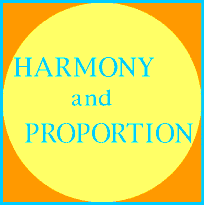When Andrea Palladio, (1508-1580), in The Four Books of Architecture, published in 1570, suggested
seven sets of the most beautiful and harmonious proportions to be used in the construction of rooms
he chose measurements which reflect musical consonances. He suggests;
 1. Circular
1. Circular
 2. Square 1:1
2. Square 1:1
 3. The diagonal of the square 1:1.414....etc.
3. The diagonal of the square 1:1.414....etc.
 4. A square plus a third 3:4
4. A square plus a third 3:4
 5. A square plus a half 2:3
5. A square plus a half 2:3
 6. A square plus two-thirds 3:5
6. A square plus two-thirds 3:5
 7. Double square 1:2
7. Double square 1:2
Compare these with Pythagoras's musical scale which we saw above:
The exception is the incommensurable proportion of the side of the square to its diagonal, or
1 : square root of 2.
(This proportion often occurs in both architecture and painting)
When Palladio goes on to talk about the generation of the height of rooms, he elucidates three types of proportion which are traditionally thought to have been discovered by Pythagoras:
- The Arithmetic Mean,
- The Geometric Mean,
- The Harmonic Mean.
